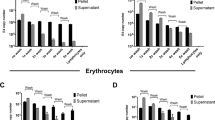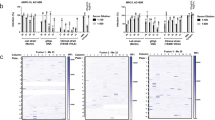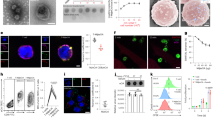Abstract
Intravenous (i.v.) delivery of therapeutic viruses to human patients exposes virus particles to the potentially neutralising environment of the human bloodstream, where many components of the innate and adaptive immune system provide a formidable barrier to virus infection of target cells. Here we assess the haemocompatibility of ColoAd1, an oncolytic adenovirus currently undergoing clinical assessment for treatment of disseminated cancer by i.v. delivery. Compared with the commonly used serotype Ad5, ColoAd1 (which has a capsid derived from Ad11p) showed only minor inhibition of oncolytic activity by pooled human serum or washed human blood cells, with the amount of ColoAd1 required to kill cancer cells in vitro (the IC50) increasing <10-fold. However, some virus–blood interactions are concentration- and context-dependent, requiring study in whole, undiluted, human blood. ColoAd1 showed <50-fold increases in the IC50 in whole blood from most donors, whereas the activity of Ad5 was ablated. Extrapolating these findings to the clinical situation indicates that ColoAd1 would ‘breakthrough’ neutralisation in some patients receiving as few as 1010 ColoAd1 particles i.v., and in most patients receiving doses of 1012 or above, well within the achievable dose range.
This is a preview of subscription content, access via your institution
Access options
Subscribe to this journal
Receive 12 print issues and online access
$259.00 per year
only $21.58 per issue
Buy this article
- Purchase on Springer Link
- Instant access to full article PDF
Prices may be subject to local taxes which are calculated during checkout




Similar content being viewed by others
References
Nemunaitis J, Cunningham C, Buchanan A, Blackburn A, Edelman G, Maples P et al. Intravenous infusion of a replication-selective adenovirus (ONYX-015) in cancer patients: safety, feasibility and biological activity. Gene Ther 2001; 8: 746–759.
Breitbach CJ, Burke J, Jonker D, Stephenson J, Haas AR, Chow LQ et al. Intravenous delivery of a multi-mechanistic cancer-targeted oncolytic poxvirus in humans. Nature 2011; 477: 99–102.
Kaufman HL, Kim DW, DeRaffele G, Mitcham J, Coffin RS, Kim-Schulze S . Local and distant immunity induced by intralesional vaccination with an oncolytic herpes virus encoding GM-CSF in patients with stage IIIc and IV melanoma. Ann Surg Oncol 2010; 17: 718–730.
Heo J, Reid T, Ruo L, Breitbach CJ, Rose S, Bloomston M et al. Randomized dose-finding clinical trial of oncolytic immunotherapeutic vaccinia JX-594 in liver cancer. Nature medicine 2013; 19: 329–336.
Khuri FR, Nemunaitis J, Ganly I, Arseneau J, Tannock IF, Romel L et al. A controlled trial of intratumoral ONYX-015, a selectively-replicating adenovirus, in combination with cisplatin and 5-fluorouracil in patients with recurrent head and neck cancer. Nat Med 2000; 6: 879–885.
Sampath P, Li J, Hou W, Chen H, Bartlett DL, Thorne SH . Crosstalk between immune cell and oncolytic vaccinia therapy enhances tumor trafficking and antitumor effects. Mol Ther 2013; 21: 620–628.
Carlisle RC, Di Y, Cerny AM, Sonnen AF, Sim RB, Green NK et al. Human erythrocytes bind and inactivate type 5 adenovirus by presenting Coxsackie virus-adenovirus receptor and complement receptor 1. Blood 2009; 113: 1909–1918.
Kalyuzhniy O, Di Paolo N, Silvestry M, Hofherr S, Barry M, Stewart P et al. Adenovirus serotype 5 hexon is critical for virus infection of hepatocytes in vivo. Proc Natl Acad Sci 2008; 105: 5483–5488.
Waddington SN, McVey JH, Bhella D, Parker AL, Barker K, Atoda H et al. Adenovirus serotype 5 hexon mediates liver gene transfer. Cell 2008; 132: 397–409.
Xu Z, Qiu Q, Tian J, Smith JS, Conenello GM, Morita T et al. Coagulation factor X shields adenovirus type 5 from attack by natural antibodies and complement. Nat Med 2013; 19: 452–457.
Kuhn I, Harden P, Bauzon M, Chartier C, Nye J, Thorne S et al. Directed evolution generates a novel oncolytic virus for the treatment of colon cancer. PLoS One 2008; 3: e2409.
Vogels R, Zuijdgeest D, van Rijnsoever R, Hartkoorn E, Damen I, de Bethune MP et al. Replication-deficient human adenovirus type 35 vectors for gene transfer and vaccination: efficient human cell infection and bypass of preexisting adenovirus immunity. J Virol 2003; 77: 8263–8271.
Lyons M, Onion D, Green NK, Aslan K, Rajaratnam R, Bazan-Peregrino M et al. Adenovirus type 5 interactions with human blood cells may compromise systemic delivery. Mol Ther 2006; 14: 118–128.
Stone D, Ni S, Li Z-Y, Gaggar A, DiPaolo N, Feng Q et al. Development and assessment of human adenovirus type 11 as a gene transfer vector. J Virol 2005; 79: 5090–5104.
Acknowledgements
Funding was provided by Cancer Research UK.
Author information
Authors and Affiliations
Corresponding author
Ethics declarations
Competing interests
Leonard Seymour and Kerry Fisher hold equity in PsiOxus Therapeutics Ltd which is developing ColoAd1 as an oncolytic virus.
Rights and permissions
About this article
Cite this article
Di, Y., Seymour, L. & Fisher, K. Activity of a group B oncolytic adenovirus (ColoAd1) in whole human blood. Gene Ther 21, 440–443 (2014). https://doi.org/10.1038/gt.2014.2
Received:
Revised:
Accepted:
Published:
Issue Date:
DOI: https://doi.org/10.1038/gt.2014.2
Keywords
This article is cited by
-
Bioreductive prodrug PR-104 improves the tumour distribution and titre of the nitroreductase-armed oncolytic adenovirus ONYX-411NTR leading to therapeutic benefit
Cancer Gene Therapy (2022)
-
A phase 1 dose escalation study of the oncolytic adenovirus enadenotucirev, administered intravenously to patients with epithelial solid tumors (EVOLVE)
Journal for ImmunoTherapy of Cancer (2019)
-
Expression of human CD46 and trans-complementation by murine adenovirus 1 fails to allow productive infection by a group B oncolytic adenovirus in murine cancer cells
Journal for ImmunoTherapy of Cancer (2018)
-
Phase 1 study of intravenous administration of the chimeric adenovirus enadenotucirev in patients undergoing primary tumor resection
Journal for ImmunoTherapy of Cancer (2017)
-
Viral vanguard: Designing cancer-killing viruses to chase metastatic tumors
Nature Medicine (2017)



